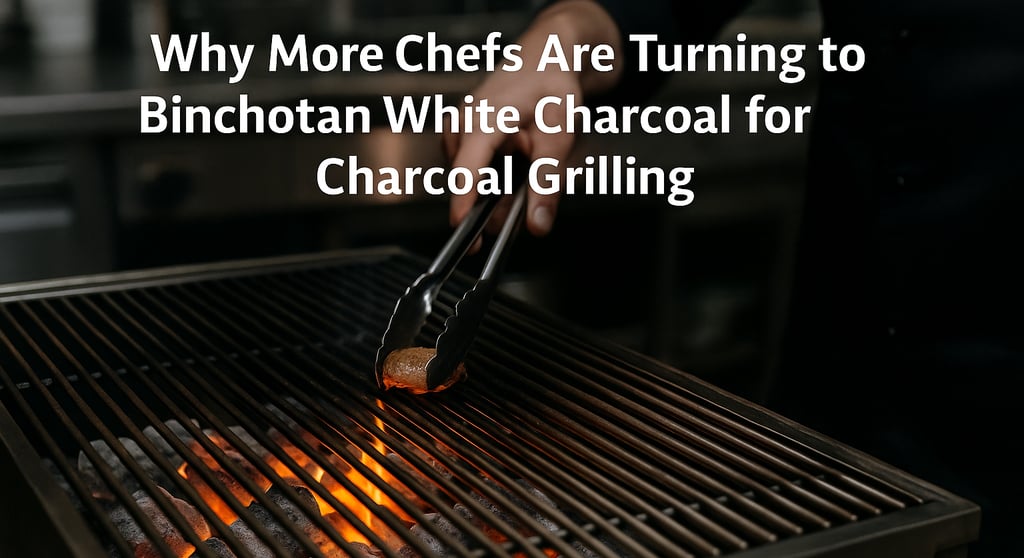Why More Chefs Are Turning to Binchotan White Charcoal for Charcoal Grilling
Deskripsi blog
widha
7/23/20254 分钟阅读


Why More Chefs Are Turning to Binchotan White Charcoal for Charcoal Grilling
In the world of professional cooking, where flavor precision and consistency are non-negotiable, more and more chefs are turning to an ancient secret from Japan: binchotan white charcoal.
If you've spent any time in a high-end Japanese or fusion grill restaurant, chances are you've already experienced the distinct taste that only this premium charcoal can deliver. As a blogger who has written about charcoal for the past 16 years, I can confidently say that binchotan isn’t just a cooking fuel—it’s a culinary tool that’s elevating kitchens across the globe.
In this article, we’ll dive into the specific reasons why charcoal grill professionals are embracing binchotan, and what makes it stand out from conventional charcoal.
What Is Binchotan White Charcoal?
Binchotan white charcoal originates from Japan and is crafted from dense hardwoods such as ubame oak, known for its purity and density. Unlike regular charcoal, binchotan is produced using a high-temperature carbonization process followed by rapid cooling with ash, resulting in a shiny, hard, and pale white appearance.
What sets it apart isn’t just how it looks—but how it performs. It burns hotter, longer, and cleaner, making it the preferred choice for chefs who care deeply about the integrity of their dishes.
1. Pure Flavor with No Smoke Interference
When grilling over regular charcoal, the smoke and impurities often seep into the food, masking its natural taste. Binchotan white charcoal, on the other hand, burns so cleanly that it produces almost no smoke or odor. This allows the natural umami of meats, vegetables, and seafood to shine through.
For chefs who are serious about maintaining the integrity of their ingredients—especially in Japanese yakitori, grilled wagyu, or Mediterranean seafood—this is a game-changer.
“With binchotan, I don’t fight with the charcoal. It lets my ingredients speak for themselves,” said Chef Martin, head of a fusion grill restaurant in Jakarta.
2. Intense, Even Heat Distribution
Ask any chef using a charcoal grill, and they’ll tell you: inconsistent heat ruins great food. Binchotan solves this with ease. Thanks to its incredibly high carbon density, binchotan emits a steady and intense heat that remains consistent for hours—sometimes even more than 5 hours.
This is crucial in busy kitchens, where chefs need a reliable heat source to manage multiple portions with exacting precision. Whether you're searing tuna or grilling lamb skewers, the even heat gives you control and confidence.
3. Minimal Smoke and Safe for Indoor Use
Many restaurants—especially in urban areas—struggle with ventilation. Too much smoke from cheap charcoal can be overwhelming, both for staff and customers.
Binchotan emits virtually no visible smoke, which makes it ideal for indoor use with proper ventilation systems. It doesn’t fill the kitchen with fumes or leave lingering smells. For open-kitchen concepts, where presentation matters as much as taste, this is a major advantage.
4. Long Burn Time = Cost Efficiency
One of the biggest misconceptions is that binchotan is too expensive. Yes, it costs more per stick than regular charcoal—but in the long run, it’s far more efficient.
Binchotan can burn for hours without breaking apart, and even after use, it can be extinguished, dried, and reused several times. This long burn time reduces the frequency of refueling and also minimizes waste, making it an excellent long-term investment for high-volume kitchens.
5. Cleaner Cooking Surface
Charcoal grilling often comes with the hassle of ash and residue that clogs grates and dirties cooking surfaces. Binchotan, due to its pure carbon structure, leaves minimal ash, making it cleaner and more convenient for chefs to work with.
This helps extend the lifespan of expensive grill equipment and saves time in post-service cleanup.
6. Adds Prestige to the Dining Experience
More chefs and restaurateurs are mentioning binchotan white charcoal on their menus—not just as a technical note, but as a branding strategy. It tells guests that the restaurant is serious about quality, tradition, and craftsmanship.
This is especially powerful in fine dining, where storytelling plays a major role. Just as sourcing Kobe beef or heirloom tomatoes adds value, so does using binchotan in your charcoal grill.
7. Eco-Friendly When Responsibly Sourced
Many chefs today are more environmentally conscious, and binchotan fits this mindset well—if sourced responsibly. Traditional binchotan is made through slow, artisanal carbonization of wood, often in small batches by skilled craftsmen. Many producers also support sustainable forestry practices.
Chefs and restaurant owners can support eco-conscious practices by choosing binchotan from certified or legally compliant sources. Always ask your supplier about the origin of the wood and whether replanting programs are in place.
8. A Ritualistic, Elevated Cooking Experience
Beyond performance and flavor, using binchotan brings a sense of ceremony and discipline to the cooking process. It requires preparation, patience, and attention—qualities that align with the mindset of serious culinary professionals.
Igniting binchotan can take longer than regular charcoal, but for many chefs, that’s part of the ritual. It slows them down, forces intentionality, and aligns them more closely with their craft.
Final Thoughts: Is Binchotan Worth It?
For any chef who takes grilling seriously, binchotan isn’t a luxury—it’s a logical upgrade. Whether you’re running a yakitori bar in Bali, a teppanyaki house in Tokyo, or a fine-dining steakhouse in New York, binchotan can dramatically improve the quality of your grilled dishes.
It enhances flavor without interference, provides steady high heat, keeps your workspace clean, and elevates your culinary identity.
In a culinary world that increasingly celebrates authenticity and excellence, binchotan white charcoal is more than just a trend—it’s a return to timeless quality.
